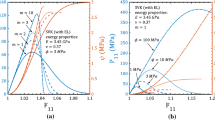Abstract
A strain gage hybrid method is described for determining individual stresses on the boundary and in the neighborhood of cutouts in orthotropic composites. Results agree with independent measurements and finite element analysis. Few measured strain data are needed, and the measured strains originate away from the hole. Ability to determine the stresses on the edge of a cutout from nonboundary measurements recognizes the difficulties in obtaining reliable measurements very near an edge while circumventing the challenge of attempting to bond gages to the transverse curved surface of a small hole or notch. The method also alleviates the problem of not knowing a priori where the most serious stress will occur on the geometric boundary and, hence, where to locate strain gages.
Similar content being viewed by others
References
Peterson, R.E., Stress Concentration Factors, John Wiley & Sons, New York (1974).
Gerhardt, T.D., “A Hybrid/Finite Element Approach for Stress Analysis of Notched Anisotropic Materials,”ASME J. Appl. Mech.,51,804–810 (1984).
Dally, J.W. andRiley, W.F., Experimental Stress Analysis, 3rd ed., McGraw-Hill, New York (1991).
Dally, J.W. and Berger, J.R., “The Role of Electrical Resistance Strain Gages in Fracture Research,” Experimental Sechniques in Fracture, ed. J.S. Epstein, VCH, 1–40 (1993).
McConnell, K.G. and Riley, W.F., “Strain-gage Instrumentation and Data Analysis,” Handbook on Experimental Mechanics, 2nd rev. ed., ed. A.S. Kobayashi, VCH, 79–117 (1993).
Lin, C.H., “A New Digital Isopachic Contouring Technique for Stress Analyzing Composite Materials,” PhD thesis, University of Wisconsin-Madison (1994).
Lin, S.T. andRowlands, R.E., “Thermoelastic Stress Analysis of Orthotropic Composites,” EXPERIMENTAL MECHANICS,35,257–265, (1995).
Rauch, B.J. andRowlands, R.E., “Determining Reliable Edge Isopachic Data from Interior Thermoelastic Measurements,” EXPERIMENTAL MECHANICS,35,174–181 (1995).
Hawong, J.S., Lin, C.H., Lin, S.T., Rhee, J., andRowlands, R.E., “A Hybrid Method to Determine Stresses in Orthotropic Composites Using Only Isochromatic Data,”J. Composite Mat.,29,2366–2387 (1995).
Rhee, J., “Geometric Discontinuities in Orthotropic Composites,” PhD thesis, University of Wisconsin-Madison (1995).
Rhee, J., He, S., andRowlands, R.E., “Hybrid Moire-numerical Stress Analysis Around Cutouts in Loaded Composites,” EXPERIMENTAL MECHANICS,36,379–387 (1996).
Baek, T.H. andRowlands, R.E., “Experimental Determination of Stress Concentrations in Orthotropic Composites,”J. Strain Anal.,34 (2),69–81 (1999).
Baek, T.H., Kim, M.S., Rhee, J., andRowlands, R.E., “Hybrid Stress Analysis of Perforated Tensile Plates Using Multiple and Sharpened Photoelastic Data and Complex-variable Techniques,”JSME Int. J.,43,327–333 (2000).
Lekhnitskii, S.G., Anisotropic Plates, trans. S.W. Tsai and T. Cheron, Gordon and Breach, New York (1968).
Savin, G.N., “Stress Distribution Around Holes,” NASA Technical Translation, NASA TT F-601 (1970).
Sanford, R.J., “Application of the Least-squares Method to Photoelastic Analysis,” EXPERIMENTAL MECHANICS,20,192–197 (1980).
Juvinall, R.C. andMarshek, K.M., Fundamentals of Machine Component Design, 3rd ed., John & Wiley Sons, New York (1999).
Tan, S.C., “Finite-width Correction Factors for Anisotropic Plate Containing a Central Opening,”J. Composite Mat.,22,1080–1097 (1988).
Barker, D.B., Sanford, R.J., andChona, R., “Determining K and Related Stress Field Parameters and from Displacement Fields,” EXPERIMENTAL MECHANICS,25,399–407 (1985).
Baek, T.H. andBurger, C.P., “Accuracy Improvement Technique for Measuring Stress Intensity Factors in Photoelastic Experiment,”KSME J.,5 (1),22–27 (1991).
Lin, S.T., “Quantitative Thermoelastic Stress Analysis of Orthotropic Composite Structures,” PhD thesis, University of Wisconsin-Madison (1994).
Author information
Authors and Affiliations
Rights and permissions
About this article
Cite this article
Baek, T.H., Rowlands, R.E. Hybrid stress analysis of perforated composites using strain gages. Experimental Mechanics 41, 195–203 (2001). https://doi.org/10.1007/BF02323197
Received:
Revised:
Issue Date:
DOI: https://doi.org/10.1007/BF02323197




